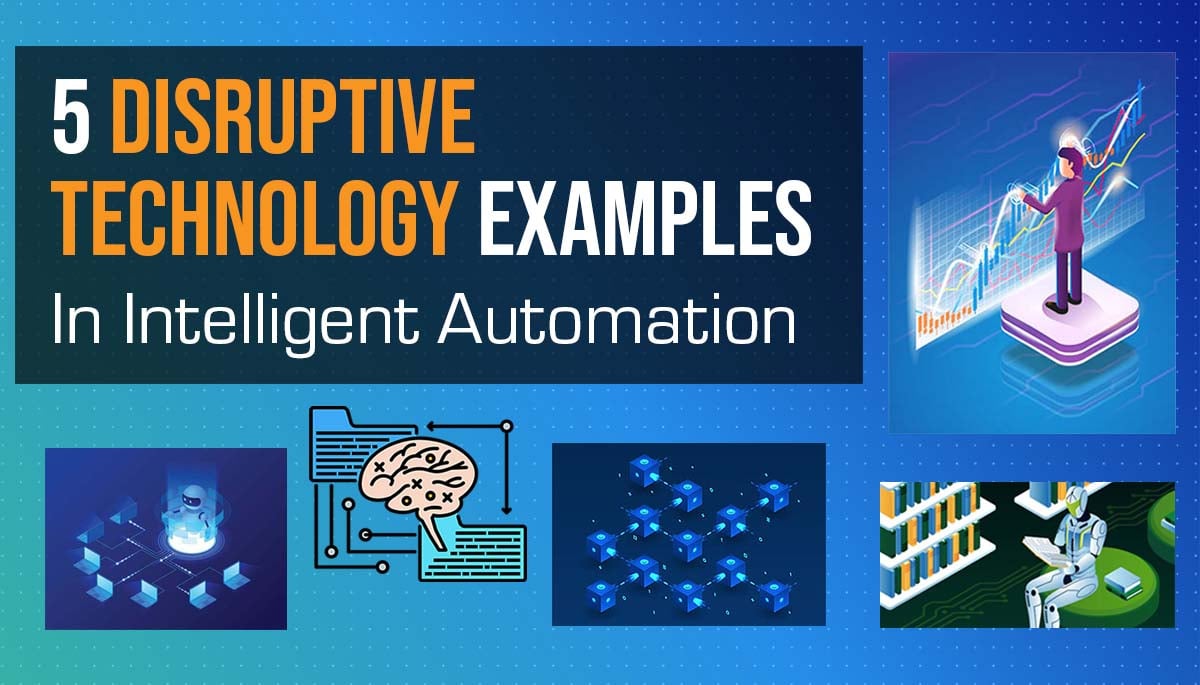The extent to which intelligent automation benefits our organizations can't be overstated.
This applies to processes and procedures that streamline and improve internal operations. It also applies to the goal of providing products, services and experiences that meet the expectations of clients whose lives are becoming more and more dependent on intelligent technology solutions.
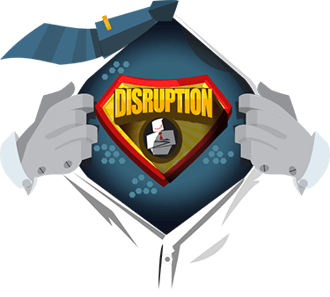 The potential is there, and the organizations that understand this have pioneered many technological innovations. This creates new markets, fundamentally reshaping the way we do business in the process.
The potential is there, and the organizations that understand this have pioneered many technological innovations. This creates new markets, fundamentally reshaping the way we do business in the process.
The phenomenon of digital technologies catalyzing a fundamental shift in conventional thinking in business, technology, industry, or culture has become known as digital disruption.
What is Disruptive Technology?
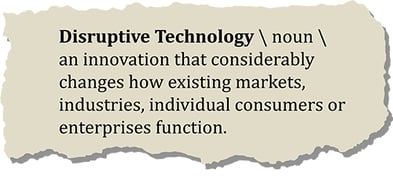 Disruptive technology is an innovation that considerably changes how existing markets, industries, individual consumers or enterprises function. A disruptive innovation replaces well-established systems, products or even habits because it has attributes that are obviously superior.
Disruptive technology is an innovation that considerably changes how existing markets, industries, individual consumers or enterprises function. A disruptive innovation replaces well-established systems, products or even habits because it has attributes that are obviously superior.
Recent disruptive technology examples include blockchain, e-commerce, and ride-sharing apps such as Uber. In previous times, electricity, the car, air conditioning and television were also disruptive technologies. Clayton M. Christensen, a professor at Harvard Business School, invented the term “disruptive technology” in a 1995 paper.
DID YOU KNOW? At least 53% of organizations are at risk for a potentially significant disruption of their current business models.
That's no surprise, considering the staggering disruptive technology examples that are already impacting our society:

- Spotify and Netflix have famously disrupted the traditional broadcasting industry.
- Airbnb and Vrbo have revolutionized the way many of us plan trips and arrange lodging, disrupting the hospitality industry in the process.
- 3D Printers have been disrupting the manufacturing industry for several years now
These are prime examples of companies whose innovations have led to serious disruptions to their respective industries. Robotics, the internet of things, artificial intelligence, cloud computing, and fintech are also significantly influencing the present and future.
New and intelligent technology is being released at a dizzying rate. It makes sense that over half of all organizations today are living on the edge of serious business disruption.
In this article, I highlight 6 current disruptive technology examples in intelligent automation:
Disruptive Technology Example #1: ChatGPT
Generative Pre-Trained Transformers (GPTs) are being widely used now and disrupting many aspects of the business world, from helping to write legal cases, to crafting blogs and marketing materials.
OpenAI's version, ChatGPT, is the most well-known and widely used, to good and interesting results. The future looks very bright for this technology, especially as other tools find ways to leverage GPTs and make them even more effective, such as how the Grooper software adopted GPT technology.
For a ton more information on how you can use ChatGPT, check out our rundown of 6 great ChatGPT use cases.
Disruptive Technology Example #2: Robotic Process Automation
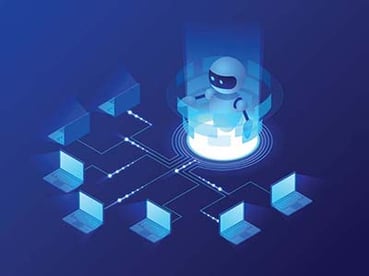 For many of us, the concept of automation conjures up images of nuts, bolts, gears, and large machines working diligently on assembly lines.
For many of us, the concept of automation conjures up images of nuts, bolts, gears, and large machines working diligently on assembly lines.
However, the reality is that the potential for automation extends far beyond industrial application.
Challenges of RPA
In this day and age, organizations of all types are utilizing various forms of automation to increase efficiency, saving time, and reducing costs in the process. With that said, as beneficial as automation can be, it comes with challenges of its own, and its implementation can prove to be a daunting undertaking.

Traditionally, when automating processes, engineers have had to identify the repetitive tasks that could benefit from automation. Then they had to design and build the required machines or software, and tediously program them to achieve the goal at hand.
Robotic Process Automation - Watching You Work?
But what if I told you that a much more intuitive way to automate processes has emerged?
What if technology could simply watch us while we work, learn what we do and how we do it, and then repeat that process on its own?
This might seem like a futuristic concept, but, thanks to advancements in Robotic Process Automation (RPA), this disruptive innovation example is already happening all around the world.
Why RPA is Disruptive
RPA utilizes software bots that are able to gather data on the ways that we interact with various applications and then emulate that behavior with minimal human involvement. While not every business process is ideal for RPA, most high volume, repetitive digital tasks that follow a consistent set of rules are perfect candidates.
For example, organizations across many industries have implemented RPA solutions to help with data entry, billing, employee onboarding, and inventory management.
We're just scratching the surface of what RPA is capable of. As the technology continues to evolve, we can be sure that it will play a big role in the disruption of many processes that are widely accepted as standard today.
Top 4 RPA Software
Disruptive Technology Example #3: Machine Learning

We've identified Robotic Process Automation as a key potential source of digital disruption, but how can technology actually learn?
That's a big question with a multi-faceted answer, but one of the main drivers of this type of digital innovation is the concept of Machine Learning.
How Does Machine Learning Work?
Machine Learning is a term widely used to describe the methods by which technology can analyze data and then use that information to draw conclusions based on the recognition of patterns.
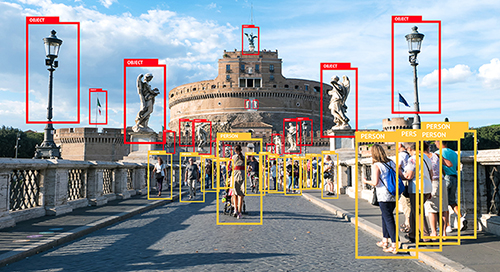
By providing the system with feedback regarding the accuracy of its conclusions, we provide new data that trains it to draw increasingly accurate conclusions, leading to higher and higher confidence in the results.
How Machine Learning is Like Golf
To better understand the cycle of Machine Learning, it's helpful to take a look inward and think about how we learn as human beings.
When I learned how to hit a golf ball, my first step was to gain an understanding of the elements involved. In order to accomplish this, I began to collect data.
 I held the driver and felt the weight of it in my hands, I assessed my surroundings, gauging the direction and speed of the wind, I looked at the ball and compared its size to the head of my club. Only then was I able to draw a conclusion about how to proceed and take an actual swing at the ball.
I held the driver and felt the weight of it in my hands, I assessed my surroundings, gauging the direction and speed of the wind, I looked at the ball and compared its size to the head of my club. Only then was I able to draw a conclusion about how to proceed and take an actual swing at the ball.
Can you guess how that went? Much to the amusement of my companions, I missed the ball entirely. I had to reevaluate my data, consider the reasons for my failure, and use that new information to adapt my process in the hopes that my next swing might be more successful.
I Used Data to Learn...Slowly
My second swing wasn't much better than the first, but as the day progressed and I continued to take swing after swing, I was able to continually evaluate my degree of success and use that information to adapt my strategy, training myself in the process.
By the end of the day, using this cycle of gathering data, drawing actionable conclusions, and gaining further data and insight by continually evaluating the success or failure of my results, I was able to successfully adjust my process and consistently hit the ball.
 Hey, I said I could hit it - not that I could hit it well! This is a simple example that does a good job of illustrating the basic cycle of Machine Learning.
Hey, I said I could hit it - not that I could hit it well! This is a simple example that does a good job of illustrating the basic cycle of Machine Learning.
How Machine Learning is a Disruptive Technology
Software works the same way. Collecting large amounts of data helps create data models that enable machines to come to actionable conclusions regarding the meaning of the data.
By continually providing feedback to the system regarding the accuracy of conclusions, the technology is trained to recognize relevant patterns and make decisions with a high degree of accuracy. This is the essence of Machine Learning, and its application is already playing an important role in the disruption of existing industries.
Top 4 Machine Learning Vendors:
Disruptive Technology Example #4:
Natural Language Processing
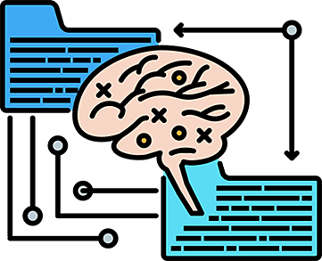
As we examine the various technologies that are contributing to business disruption, a trend is emerging: data is the name of the game.
Before technology can learn, automate, or make predictions, it must first be provided with relevant data. The more, the better!
The Language Obstacle
One of the challenges that consumers face in this regard is getting that data from point A to point B. Since computers and humans don't speak the same language, this can often be a tedious process that requires human beings to structure the data in a way that computers can understand before importing it into the system.
Luckily, the tech community has been working hard to bridge that gap. One of the most exciting prospects on this frontier is the concept of Natural Language Processing (NLP).

Humans read and write in a variety of extremely complex natural languages that have evolved over thousands of years; however, these languages were developed with the sole objective of enabling communication between human beings.
Verbal or written communication with technology wasn't even a consideration until the 20th century, and that's where NLP comes in.
What is Natural Language Processing?
The goal of NLP is to create systems that are able to read or hear human languages and process that data in a meaningful way.
This will facilitate a more natural level of communication between us and our technological counterparts.
Examples of NLP as a Disruptive Technology
One obvious application for NLP that most of us are familiar with is the advent of the virtual assistant.
 Virtual assistants like Apple's Siri or Amazon's Alexa are able to act on verbal commands, interpreting meaning of the spoken words and performing the requested task. And this application of NLP is just the tip of the iceberg.
Virtual assistants like Apple's Siri or Amazon's Alexa are able to act on verbal commands, interpreting meaning of the spoken words and performing the requested task. And this application of NLP is just the tip of the iceberg.
There is an incredible amount of unstructured data that is continually being produced by humans for human consumption. NLP is opening the floodgates, allowing our technology to interface with that data in new and disruptive ways.
Disruptive Technology Example #5:
Augmented Analytics
 While Machine Learning and Natural Language Processing are already providing many benefits to us on their own, they are predicted to rapidly join forces in the years to come.
While Machine Learning and Natural Language Processing are already providing many benefits to us on their own, they are predicted to rapidly join forces in the years to come.
This will drastically increase the potential for businesses to understand the meaning of large amounts of data that once might have been thought too vast and unstructured to even consider.
Most of the data that currently exists was created using human languages with the goal of enabling human understanding.
How Massive Amounts of Data = Great Potential
But, as Natural Language Processing continues to evolve, the incredible amounts of data that we produce will become more and more accessible to our technology.
Based on that data, we will be able to identify important business trends and even make predictions. Business leaders will have important insights that will allow them to make decisions that lead to more desirable outcomes.
The potential is so great that Gartner, Inc. - a leading research and advisory company - believes that augmented analytics represents the next wave of disruption in the data and analytics market.
Why Augmented Analytics Can Be a Disruptor
Augmented analytics is a powerful disruptor is due to it's ability to create valuable, real-time insight from emerging data sources. Traditional analytics in the form of reports and dashboards are rigid, and manually structured. Augmented analytics turns the table on what users will do with data.
 Now, data visualizations are auto-generated. Modern analytics platforms enable rapid and accurate forecasting and on-the-fly decision making. Previously inaccessible or obscure data is now part of advanced auto-prescriptive functionality.
Now, data visualizations are auto-generated. Modern analytics platforms enable rapid and accurate forecasting and on-the-fly decision making. Previously inaccessible or obscure data is now part of advanced auto-prescriptive functionality.
One of the best applications for augmented analytics is machine learning model development. Now, business problems that have a massive number of data points or changing relationships with datasets are approachable like never before. Users are no longer burdened by trying to manually find patterns in data and correlating endless combinations of variables.
Disruptive Technology Example #6: Blockchain
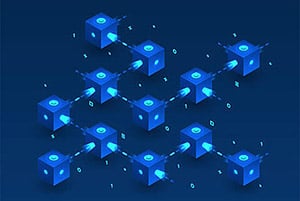
World governments generally measure their strength by their ability to project power across human domains (check out this interesting article on measuring power).
For centuries, these areas of operation were limited to sea and land, and, in the 20th century, expanded to include the domains of air and space.

The 21st century has brought a new domain to the forefront: Cyberspace.
The digital world is a real, tangible place where we connect, learn, share ideas, seek entertainment, and engage in commerce. This reality has led to important advancements that enable us to engage the digital landscape in more transparent, secure ways.
One such advancement is the emergence of the disruptive innovation, Blockchain. Blockchain technology has led to the rise of cryptocurrencies such as Bitcoin and Ethereum, and has the potential for many other applications, but how does it work?
How Does Blockchain Work?
Essentially, the Blockchain is a chronological series of digital ledgers that record transactional data in a decentralized way.
When a transaction occurs on the blockchain, that information is cryptographically stored in a collection of data called a block.

Subsequent transactions don't change the data in that block, but, instead, result in the creation of new, timestamped blocks of information that are then added to the end of the current series of blocks.
What Makes Blockchain Different, and Disruptive?
Once we understand the basic concept, it's easy to visualize this chronological series of groups of data as a chain of blocks, but you might be wondering what sets Blockchain technology apart?
After all, our society is already successfully using various types of ledgers to record transactional data, so what does Blockchain bring to the table?
 The answer lies in the cryptographic and decentralized nature of the technology. Traditionally, ledgers have been maintained in a central location, like a book or a spreadsheet, and the data contained within these ledgers is often not encoded in any way.
The answer lies in the cryptographic and decentralized nature of the technology. Traditionally, ledgers have been maintained in a central location, like a book or a spreadsheet, and the data contained within these ledgers is often not encoded in any way.
This can work when we trust the way the ledgers are maintained, but it puts the data in an unnecessarily vulnerable position.
With traditional ledgers, it can often take just one malicious party to access the data and permanently alter it.
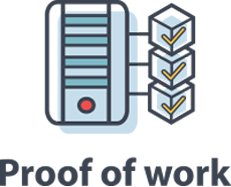 Blockchain technology solves this problem by cryptographically encoding all data within the Blockchain and distributing the entire chain across a large network of computers.
Blockchain technology solves this problem by cryptographically encoding all data within the Blockchain and distributing the entire chain across a large network of computers.
Multiple computers on the Blockchain's network must verify and agree upon any changes to the encrypted transactional data before a new block can be added to the chain.
Blockchain is Secure But Transparent
Because the data itself is highly encrypted, and no single party has the authority to alter it, additional layers of security and trust are provided to Blockchain users.
And since the data is held on multiple computers across the network, the transactional chain is that much more traceable and transparent.
 The high level of trust that Blockchain users have in the security of their data has led to the widespread adoption of cryptocurrencies as a safe alternative to traditional currency. This has already resulted in a degree of disruption to traditional transactional models.
The high level of trust that Blockchain users have in the security of their data has led to the widespread adoption of cryptocurrencies as a safe alternative to traditional currency. This has already resulted in a degree of disruption to traditional transactional models.
As we discover new applications for Blockchain technology and further integrate it into our lives, its potential to digitally disrupt current business models demands the attention of leaders who wish to stay ahead of the curve.
Top 4 Blockchain Vendors:
Final Thoughts on Disruptive Technologies
We all know that humanity and technology are intrinsically linked. Technology is merely a natural extension of our desire to not only achieve our goals, but to do so in a way that leads to increasingly positive outcomes.
 The evolution of technology has always impacted the way we work, think, and interact with one another. It disrupting and improving upon traditional models of virtually all human practices in the process, and that trend continues today at an ever-accelerating pace.
The evolution of technology has always impacted the way we work, think, and interact with one another. It disrupting and improving upon traditional models of virtually all human practices in the process, and that trend continues today at an ever-accelerating pace.
We find ourselves in the midst of one of the greatest technological transformations in history.
So it's paramount that business leaders put them - and their teams - in a place that will let them take advantage of the opportunities that are presented by the digital realities of today. That includes disruptive innovation examples fueling intelligent automation to make products accessible and more affordable.
But they must also anticipate the possibilities that tomorrow will bring.
